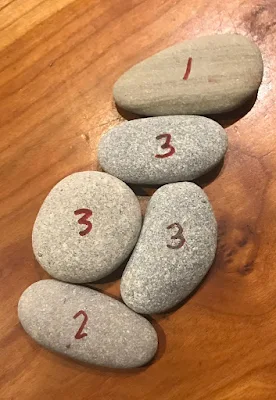Certainly the face of a particular stone needs to touch its neighbouring stones in more than one or even two places if it is to be stable. Three places would be the minimum for it not to 'wiggle'.
After three starter stones are placed randomly on the board, the first player plays one of his or her stones so that it is touching the others in certain way. Our first rule might be that any stone piece that is placed on the flat playing board (perhaps they are made of cardboard or plastic or even small flat stone pieces, as in the photo above) scores three points if it touches in three places. If it touches in two there is no score. If it touches in only one a point is taken off the players score.
( For the purpose of simplifying the rules for the time being, a stone touching more than three places will not be allowed.)
( For the purpose of simplifying the rules for the time being, a stone touching more than three places will not be allowed.)
The pattern that is created can ramble off in any direction. It doesn't have to have a height or length as in a vertical wall, for this part of the challenge.
------------
To understand how a one player game might be developed, here is a different challenge – Using a random selection of polygonal convex pieces (no inside corners) to represent basically the oval shaped faces of stones showing in a wall, add them one at a time to the board and see how few you need to use to have every one touching three and only three other stones.
Obviously you will need to use more than three stone pieces, but what is the minimum number that would fulfill the requirement of every stone touching three and only three others, and how would this configuration look?
In the photo above I have started with five stones, so far three are touching in three places, one is only touching in one, and one is only touching in two.
